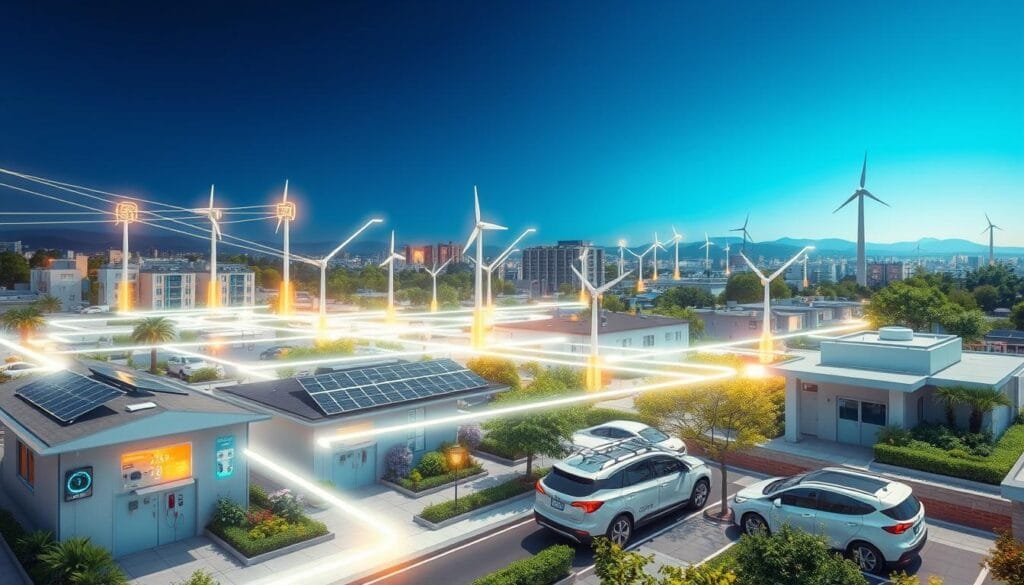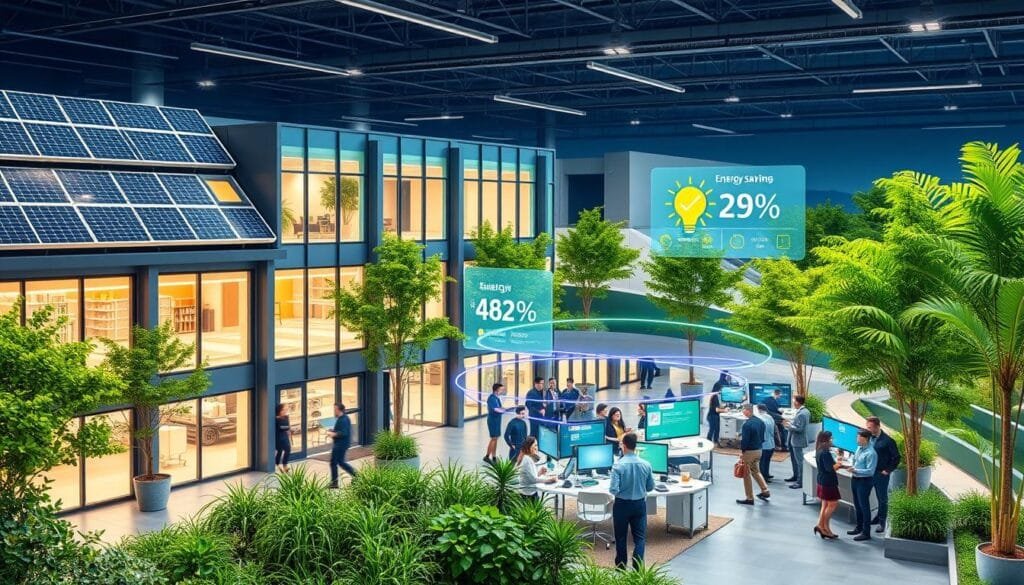Electricity generation is a big source of global greenhouse gas emissions. But, negawatts are changing how we view energy use. Negawatts are about cutting down electricity demand, not just making more power.
The idea of negawatts is simple yet effective. We can save energy by using smart tech and new ways to conserve. For example, switching to a 15-watt smart bulb from a 100-watt one saves 85 watts of energy.
Now, saving energy is smart and good for your wallet. Smart home tech and advanced energy systems make it easy to save energy without big changes. This lets people help reduce their energy use and maybe even save money.
Key Takeaways
- Negawatts represent electricity demand reduction through conservation
- Smart technologies enable effortless energy efficiency
- Saving a kilowatt is more valuable than generating a kilowatt
- Energy conservation can lead to significant economic benefits
- Innovative technologies make reducing energy consumption easier
Understanding the Concept of Negawatts
Negawatts are a new way to think about energy. They focus on saving energy and reducing usage. This is different from just making more power.
A negawatt is the amount of electricity saved through smart energy use. Amory Lovins introduced this idea in 1989. It’s a key part of managing energy demand.
Definition and Basic Principles
The idea of negawatts is simple. Saved energy is just as valuable as new energy. Here are some important points:
- Energy saving can be cheaper than making new power.
- Switching to an LED bulb can save a lot of energy.
- Utilities can save money by encouraging people to use less energy.
The Origins of Negawatt Theory
“Electricity conservation is not about deprivation, but about intelligent use of resources.” – Amory Lovins
The negawatt theory started from a simple idea. It’s better to use energy wisely than to make more. This helps the environment and saves money.
How Negawatts Differ from Traditional Energy Units
Negawatts are different from megawatt hours (MWh). MWh measures power made, while negawatts measure power saved. This is very important during high demand times.
- Traditional measure: Megawatt hours (MWh) of generation
- Negawatt measure: Watts of electricity conserved through efficiency
- Key benefit: Reduced need for additional generation capacity
The Economics of Energy Reduction
The way we manage energy has changed a lot in recent years. Negawatt strategies are now key to cutting down energy costs. They bring big financial gains. In the U.S., energy-saving programs have shown to be very cost-effective.
These programs offer big savings compared to old ways of getting more energy.
The savings from not using energy are huge. Here are some important points:
- The American Recovery Act gave over 11 percent of $831 billion to energy spending
- $32 billion went to energy efficiency and retrofitting projects
- A $500 billion investment could lead to $1.2 trillion in savings
Peak shaving is a big deal for businesses and utilities. It helps cut costs by using less energy when it’s most expensive. This not only saves money now but also helps in the long run.
“Energy efficiency is not just an environmental strategy—it’s a powerful economic tool that can transform how we approach resource management.”
There are many economic benefits to reducing energy:
- Lowering what it costs to run things
- Less money needed for energy systems
- Less money spent on carbon-related rules
- Being more stable and strong
Studies say we could cut energy use by 23 percent by 2020. This shows how big the economic benefits of negawatt strategies can be.
Smart Energy Management Systems
Energy consumption has changed a lot, leading to new ways to manage electricity. Smart grid technologies are changing how we use energy. They make power management smarter and more efficient.
Today’s homes are getting smarter about saving energy. They use advanced tech for better control over electricity. This includes smart monitoring and automated systems.
Integration of Smart Home Technology
Smart home tech lets homeowners control energy use like never before. It offers:
- Automated temperature control
- Real-time energy tracking
- Smart appliance management
- Algorithms for better energy use
“Saving energy is no longer about sacrifice, but about smart technology and intelligent choices.” – Energy Innovation Expert
Automated Energy Conservation Methods
Automated systems cut down on energy waste with smart strategies. They use advanced algorithms to adjust energy use.
| Conservation Method | Energy Savings |
|---|---|
| Smart Thermostat Scheduling | 10-15% Reduction |
| Automated Lighting Controls | 5-10% Reduction |
| Intelligent Power Management | 15-20% Reduction |
Real-time Energy Monitoring Solutions
Advanced monitoring gives users instant insights into their energy use. It helps change behavior by showing detailed energy patterns.
- Cloud-based tracking systems
- Mobile app interfaces
- Predictive consumption analytics
Using smart grid tech and smart energy systems, people can cut down on electricity. They can do this without losing comfort or convenience.
Peak Demand Management and Load Reduction
Energy networks face big challenges during peak demand times. Demand-side management is a strong solution to these issues. By using smart peak shaving, companies can cut down on electricity use when the grid is most stressed.
“Managing energy demand is more cost-effective than generating additional power during peak times.”
Utilities and businesses are now using new demand management strategies. These methods help save money and make the grid more stable. They also help the environment.
- Emergency demand response programs provide critical grid support
- Economic incentives encourage energy reduction during peak hours
- Smart grid technologies enable real-time demand management
Key demand management techniques include:
| Strategy | Duration | Potential Savings |
|---|---|---|
| Critical Peak Pricing | Specific seasons/times | Up to 15% reduction |
| Time of Use Programs | 15-30 minutes notice | Credit accumulation |
| Microgrid Integration | Continuous | Renewable energy optimization |
By 2030, we could save up to 10% of total electricity demand. This shows how powerful demand-side management can be.
Companies using full energy management systems can greatly reduce their load. This is done without losing efficiency. The future of energy management is about being smart and adaptable, balancing money and the environment.
The Environmental Impact of Negawatts
Negawatts are a key to saving energy that goes beyond just managing it. They help us use less energy, which is great for the planet. This approach can change how we think about being green.
Carbon Footprint Reduction
Using energy wisely is key to cutting down on carbon emissions. The U.S. often wastes a lot of the energy it makes. But, by using negawatts, we can cut down our carbon footprint a lot.
- LED bulbs use up to 80% less energy than traditional incandescent bulbs
- Heating and cooling systems account for approximately 50% of household energy use
- Smart technologies can optimize real-time energy consumption
Sustainable Energy Practices
Keeping our planet safe means using energy in a way that’s good for the environment. The negawatt idea, brought up by Amory Lovins in 1989, is about using less energy to make more.
“Energy efficiency initiatives represent the lowest capital investment, lowest risk, and shortest implementation timelines for reducing energy consumption and carbon emissions.”
Environmental Benefits of Energy Conservation
Using negawatts can make a big difference for our planet. Here are some benefits:
- Cleaner air quality
- Reduced pollution levels
- Preservation of ecological systems
- Decreased dependency on fossil fuel generation
By focusing on saving energy, we can make our future greener and reduce harm to the environment.
Smart Grid Integration and Demand Response
The smart grid is changing how we use and manage electricity. Demand-side management is key to balancing energy use and keeping the grid stable. Now, thanks to smart grid tech, people can help optimize energy use.

Demand response programs bring new ways to manage energy. They let people change their energy use during busy times. This helps both the grid and the people using it.
- Reduce peak electricity demand
- Lower energy costs
- Enhance grid reliability
- Support renewable energy integration
“The future of energy is not just about generation, but intelligent consumption.” – Energy Innovation Expert
Smart grid tech has opened up new chances for saving energy. Flexiwatts are a big step forward. They let people change when they use energy, making it more efficient.
| Demand Response Category | Key Characteristics |
|---|---|
| Shed | Reduce electricity consumption during peak hours |
| Shape | Modify overall energy consumption patterns |
| Shift | Move energy usage to different time periods |
| Shimmy | Provide grid balancing services |
Smart devices and IoT tech are key for demand response. They help monitor and adjust energy use in real-time. This makes it simpler for people to help the grid.
Residential Energy Efficiency Solutions
Today, homeowners have tools to cut down energy use and help the planet. By using energy-saving strategies, they can lower their environmental footprint and save money too.
To change how homes use energy, we need a mix of new tech and smart habits. This approach aims to save energy for both homes and the environment.
Home Energy Audits: Your First Step
Home energy audits are key to making homes more energy-efficient. They find where energy is wasted and suggest ways to fix it.
- Identify air leakage points
- Assess insulation quality
- Evaluate appliance energy consumption
- Recommend cost-effective upgrades
Smart Appliance Implementation
Smart appliances change how we manage energy by using less power. These devices help cut down on energy waste.
| Appliance Type | Potential Energy Savings |
|---|---|
| Smart Thermostats | 10-15% heating/cooling reduction |
| Energy-Efficient Refrigerators | 15-20% electricity savings |
| LED Lighting Systems | 75% energy reduction |
Behavioral Modifications for Energy Savings
Energy efficiency is not just about gadgets. It’s also about changing our habits. Simple changes can make a big difference.
- Adjust thermostat settings
- Maximize natural lighting
- Unplug electronics when not in use
- Use energy-efficient appliance settings
“Every kilowatt saved is a kilowatt that doesn’t need to be generated.” – Energy Conservation Expert
Cities like Ithaca, NY show how big a difference energy-saving plans can make. They plan to make 1,000 buildings more energy-efficient in just 1,000 days. This shows how focused efforts can lead to big changes.
Commercial Applications of Negawatt Principles

Businesses are now seeing how important energy efficiency is. It helps cut down costs and harm to the environment. By using negawatt principles, companies can lower their energy use and reduce their carbon footprint.
There are several ways to make energy use better in businesses:
- Implementing smart building controls
- Retrofitting existing infrastructure
- Upgrading to high-efficiency HVAC systems
- Integrating advanced energy management systems
Lighting is a big chance to use less energy. Studies show that a lot of electricity in big office buildings goes to lights. By using the latest in fluorescent lighting, companies can see big improvements:
| Retrofit Metric | Performance Outcome |
|---|---|
| Energy Savings | 70-90% reduction |
| Payback Period | 1-2 years |
| Annual Savings per Sq. Ft. | Over $1 |
Data centers and industrial places can also gain a lot from negawatt ideas. By using smart monitoring and controls, they can cut down their energy use a lot.
“Every unit of electricity saved at the point of use typically saves 3-4 units of fuel at power plants” – Energy Efficiency Expert
The money side is also very appealing. U.S. businesses spend about $100 billion a year on electricity. Making energy use better is not just good for the planet but also smart for the wallet.
Financial Incentives and Energy Efficiency Programs
Exploring energy savings can seem tough, but financial perks make it easier. Both homes and businesses can find ways to cut energy costs. This supports green practices.
Government and utility programs push for saving energy. They offer big savings for those who care about energy. These programs give many financial benefits.
Government Rebates and Tax Credits
The federal government gives great incentives for energy-saving steps:
- Tax deductions up to $1.80 per square foot for buildings that cut energy costs by 50%
- Rebate programs for homes and businesses to upgrade energy efficiency
- Big credits for using energy-saving technologies
Utility Company Initiatives
Utility companies play a big role in saving energy with new programs:
| Program Type | Key Benefits | Potential Savings |
|---|---|---|
| Demand Response | Less energy use during peak times | Up to 65 megawatts saved |
| Energy Audits | Finds ways to save energy | Personalized savings tips |
| Smart Switch Programs | Control energy use remotely | Over 61,400 switches used |
Return on Investment Analysis
“Energy efficiency investments today can generate financial returns for years to come.” – Energy Efficiency Expert
Companies that focus on energy savings can get big financial rewards. PJM Interconnection, covering 13 states, offers big incentives. The EDF Climate Corps found nearly $1.4 billion in savings for different groups.
By choosing energy-saving steps, people can turn energy costs into smart investments. These investments help both the wallet and the planet.
Technology Innovations in Energy Conservation
The world of energy saving is changing fast with new tech. Smart grid systems are making it easier to use energy wisely. They let us control and improve how we use power.

New tech is coming that cuts down energy use without losing performance. Smart home gadgets are leading the way:
- Smart bulbs using only 15 watts instead of 100 watts
- Imperceptible dimming technologies
- Advanced energy management software
- AI-driven consumption prediction systems
Artificial intelligence and machine learning are key in saving energy. They help predict and adjust how much energy we use. This saves a lot of energy without making us uncomfortable or less productive.
“The future of energy conservation lies not in generating more power, but in using existing power more intelligently.” – Energy Innovation Expert
| Technology | Energy Savings Potencial | Implementation Complexity |
|---|---|---|
| Smart Home Systems | 25-40% | Medium |
| AI Energy Management | 35-50% | High |
| Advanced Metering | 15-30% | Low |
New tech in building materials, appliances, and industrial processes is changing energy saving. With smart grid systems, businesses and people can save energy better than ever.
Measuring and Verifying Energy Savings
Understanding energy savings needs advanced methods. It’s key to measure load reduction well. This helps both groups and individuals to improve their energy use.
Today, we use new ways to track energy savings. Real-time monitoring has changed how we see and work on energy savings.
Performance Metrics for Energy Efficiency
Important metrics help us see how well we save energy. These metrics give us insights into how much energy we use and how we can use less.
- Energy Use Intensity (EUI)
- Savings-to-Investment Ratio
- Normalized Energy Consumption
- Carbon Emission Reductions
Monitoring Tools and Technologies
Smart tech has changed how we track energy savings. New tools let us measure energy use and efficiency very accurately.
| Technology | Functionality | Accuracy |
|---|---|---|
| Smart Meters | Real-time Energy Tracking | 95-98% |
| Energy Management Systems | Comprehensive Consumption Analysis | 90-95% |
| IoT Sensors | Granular Usage Monitoring | 85-90% |
Data Analysis Methods
Advanced data analysis turns raw data into useful insights. Interval data analytics help us understand energy use patterns. This way, we can find ways to use less energy.
Energy efficiency is the “first fuel” in modern energy management strategies. – International Energy Agency
By using the latest in measurement and verification, we can make our energy savings efforts better. This helps us use energy more sustainably.
Case Studies: Successful Negawatt Implementation
Energy efficiency and demand-side management have changed how companies use power. Real-world examples show the big impact of negawatt strategies in various fields.
“Saving energy is not just about reducing consumption, but about smart resource management.” – Energy Efficiency Expert
Texas is a great example of negawatt success. The state has saved a lot of energy by encouraging people to use less. They saved about three times as much as they spent on these programs.
Innovative Case Studies
- Virginia Tech’s Interruptible Load Reliability program reduced energy consumption by 7,000 kWh
- Residential “Smart Cooling Rewards” program giving annual credits to homeowners
- Yokohama Smart City Project showing advanced negawatt hour trading
Using demand-side management shows a lot of energy can be saved. Smart technologies and new ideas help companies use less energy.
| Program | Energy Reduction | Financial Benefit |
|---|---|---|
| Virginia Tech Program | 7,000 kWh | $240,000 |
| Smart Cooling Rewards | Variable | $40 Annual Credit |
| Yokohama Smart City | Multiple Industries | Comprehensive Energy Trading |
These examples show how negawatt strategies can change things. By focusing on saving energy and smart use, companies can save money and help the planet.
Future Trends in Energy Efficiency
The world of energy efficiency is changing fast. New technologies and smart grid solutions are leading the way. As we approach 2050, we’ll see big changes in how we use and save energy.
Some key trends include:
- Artificial Intelligence (AI) powered energy management systems
- Advanced Internet of Things (IoT) integration
- Machine learning predictive technologies
- Decentralized energy conservation strategies
Smart grid tech and energy efficiency are coming together. Intelligent systems will help us use energy better without needing to do it ourselves.
“The future of energy is not about generating more, but about using less intelligently.” – Energy Innovation Expert
New tech will change how we use energy. By 2050, we could see a 28% drop in energy use thanks to advanced tech.
| Technology | Potential Energy Savings | Implementation Timeline |
|---|---|---|
| AI Energy Management | 15-25% | 2025-2030 |
| IoT Integration | 10-20% | 2023-2028 |
| Smart Grid Solutions | 20-30% | 2025-2035 |
Clean energy investments, set to hit $30.3 trillion by 2030, will boost these new techs. This will help us move towards a greener future.
Conclusion
Negawatts show us a new way to save energy that’s more than just turning off lights. The U.S. could use electricity four times more efficiently with smart energy plans. This silent revolution lets us all play a big role in saving the planet.
Now, saving energy is key for a greener future. Studies show we can cut electric use by 29% with simple changes. This is true for homes, businesses, and factories, thanks to new tech.
New tech like smart lights and better cooling systems are game-changers. They show us how negawatts can make a big difference. With smart homes and buildings, we’re moving towards a better energy future.
This shift towards energy saving is for everyone. Every small step we take helps fight climate change. It’s time to make smart energy choices for a better tomorrow.

